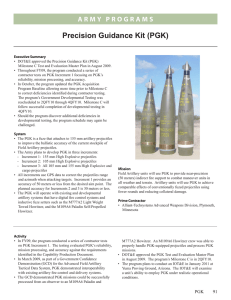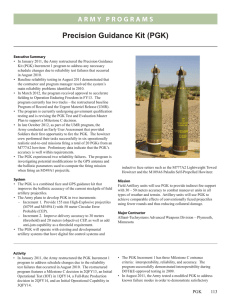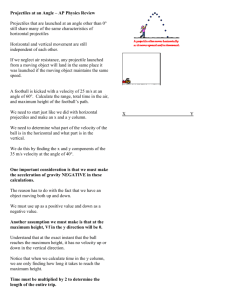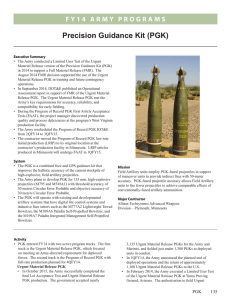Precision Guidance Kit (PGK)
advertisement
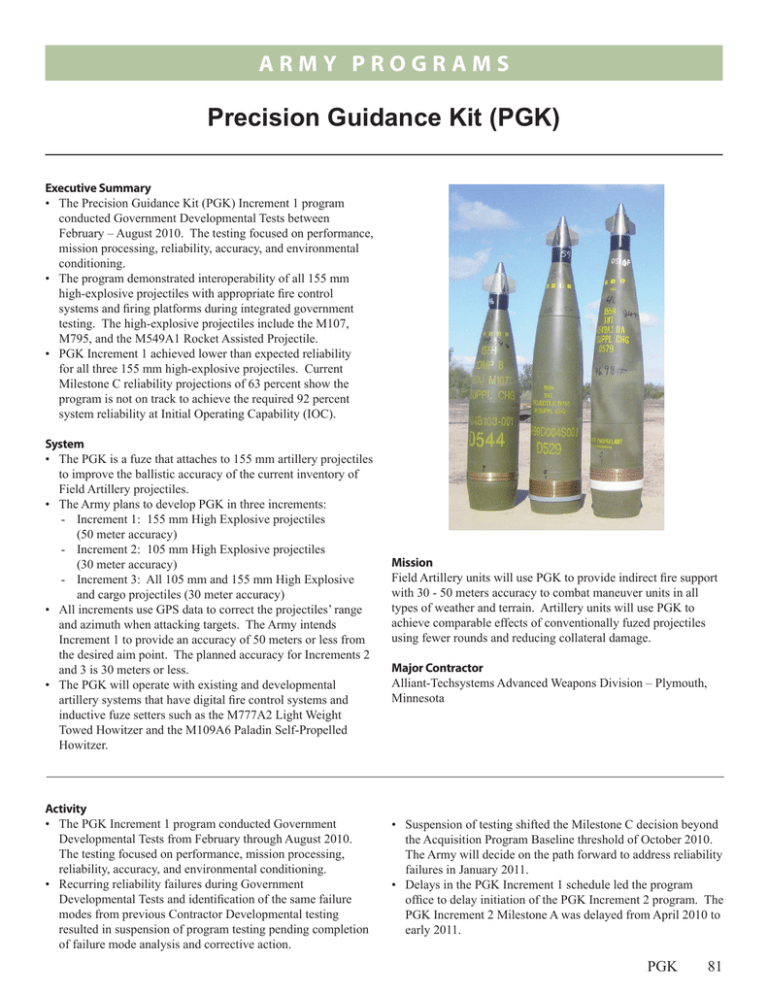
ARMY P ROGRAMS Precision Guidance Kit (PGK) Executive Summary • The Precision Guidance Kit (PGK) Increment 1 program conducted Government Developmental Tests between February – August 2010. The testing focused on performance, mission processing, reliability, accuracy, and environmental conditioning. • The program demonstrated interoperability of all 155 mm high-explosive projectiles with appropriate fire control systems and firing platforms during integrated government testing. The high-explosive projectiles include the M107, M795, and the M549A1 Rocket Assisted Projectile. • PGK Increment 1 achieved lower than expected reliability for all three 155 mm high-explosive projectiles. Current Milestone C reliability projections of 63 percent show the program is not on track to achieve the required 92 percent system reliability at Initial Operating Capability (IOC). System • The PGK is a fuze that attaches to 155 mm artillery projectiles to improve the ballistic accuracy of the current inventory of Field Artillery projectiles. • The Army plans to develop PGK in three increments: - Increment 1: 155 mm High Explosive projectiles (50 meter accuracy) - Increment 2: 105 mm High Explosive projectiles (30 meter accuracy) - Increment 3: All 105 mm and 155 mm High Explosive and cargo projectiles (30 meter accuracy) • All increments use GPS data to correct the projectiles’ range and azimuth when attacking targets. The Army intends Increment 1 to provide an accuracy of 50 meters or less from the desired aim point. The planned accuracy for Increments 2 and 3 is 30 meters or less. • The PGK will operate with existing and developmental artillery systems that have digital fire control systems and inductive fuze setters such as the M777A2 Light Weight Towed Howitzer and the M109A6 Paladin Self-Propelled Howitzer. Mission Field Artillery units will use PGK to provide indirect fire support with 30 - 50 meters accuracy to combat maneuver units in all types of weather and terrain. Artillery units will use PGK to achieve comparable effects of conventionally fuzed projectiles using fewer rounds and reducing collateral damage. Activity • The PGK Increment 1 program conducted Government Developmental Tests from February through August 2010. The testing focused on performance, mission processing, reliability, accuracy, and environmental conditioning. • Recurring reliability failures during Government Developmental Tests and identification of the same failure modes from previous Contractor Developmental testing resulted in suspension of program testing pending completion of failure mode analysis and corrective action. • Suspension of testing shifted the Milestone C decision beyond the Acquisition Program Baseline threshold of October 2010. The Army will decide on the path forward to address reliability failures in January 2011. • Delays in the PGK Increment 1 schedule led the program office to delay initiation of the PGK Increment 2 program. The PGK Increment 2 Milestone A was delayed from April 2010 to early 2011. Major Contractor Alliant-Techsystems Advanced Weapons Division – Plymouth, Minnesota PGK 81 A r m y P ROGRAMS • In June 2010, with receipt of additional incremental funding, the Army redesignated the program as Acquisition Category (ACAT) II and authorized PGK Increment 2 to continue preparations for Milestone A. Assessment • PGK Increment 1 has three Milestone C Entrance Criteria: interoperability, reliability, and accuracy. The program has successfully demonstrated interoperability. • The program demonstrated interoperability of all 155 mm high-explosive projectiles with appropriate fire control systems and firing platforms during integrated government testing. The high-explosive projectiles include the M107, M795, and the M549A1 Rocket Assisted Projectile. • PGK Increment 1 continues to experience lower than expected reliability for all three 155 mm high-explosive projectiles. Current reliability projections of 63 percent are below the Milestone C reliability entrance criterion and do not support achieving the 92 percent reliability requirement at IOC. 82 PGK • The program is meeting accuracy requirements for two of the three 155 mm high-explosive projectiles at low- and mid‑quadrant elevations below 800 mils (low-angle fire). PGK Increment 1 has not demonstrated accuracy requirements for the M107 high-explosive projectile. The program has not achieved accuracy requirements for any of the three high‑explosive projectiles when fired at high quadrant elevations above 800 mils (high-angle fire). Recommendations • Status of Previous Recommendations. The Army satisfactorily addressed all previous recommendations. • FY10 Recommendations. 1. The Army should continue to closely monitor the program and determine the operational impacts of the delayed testing and Milestone C. 2. Develop and implement through testing a plan to address PGK recurring reliability failures.
